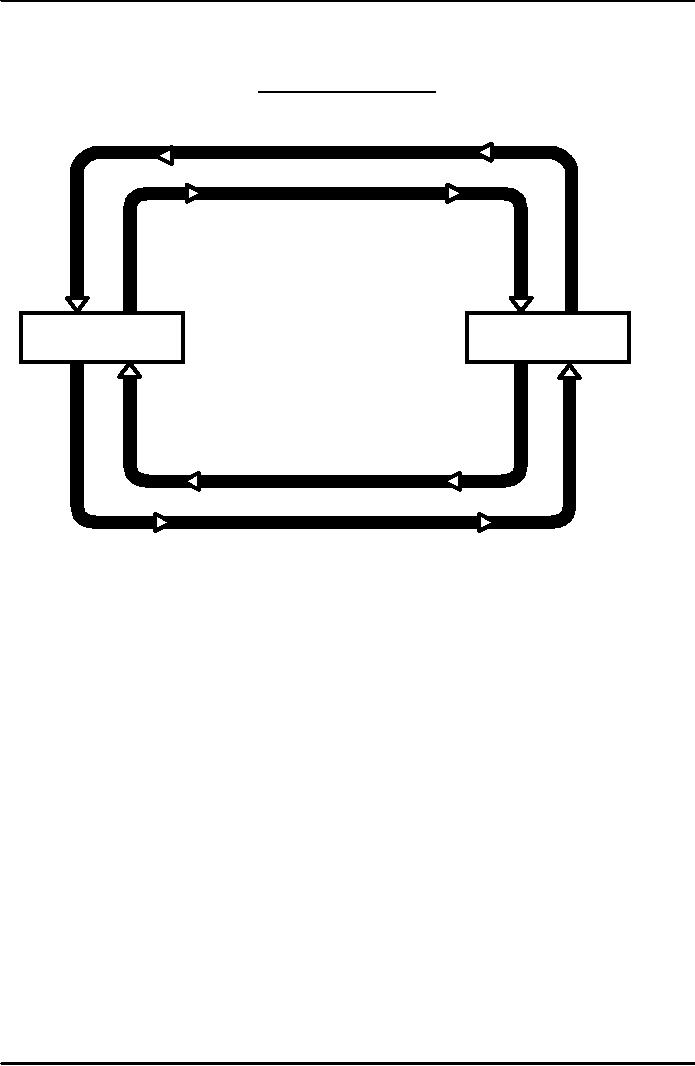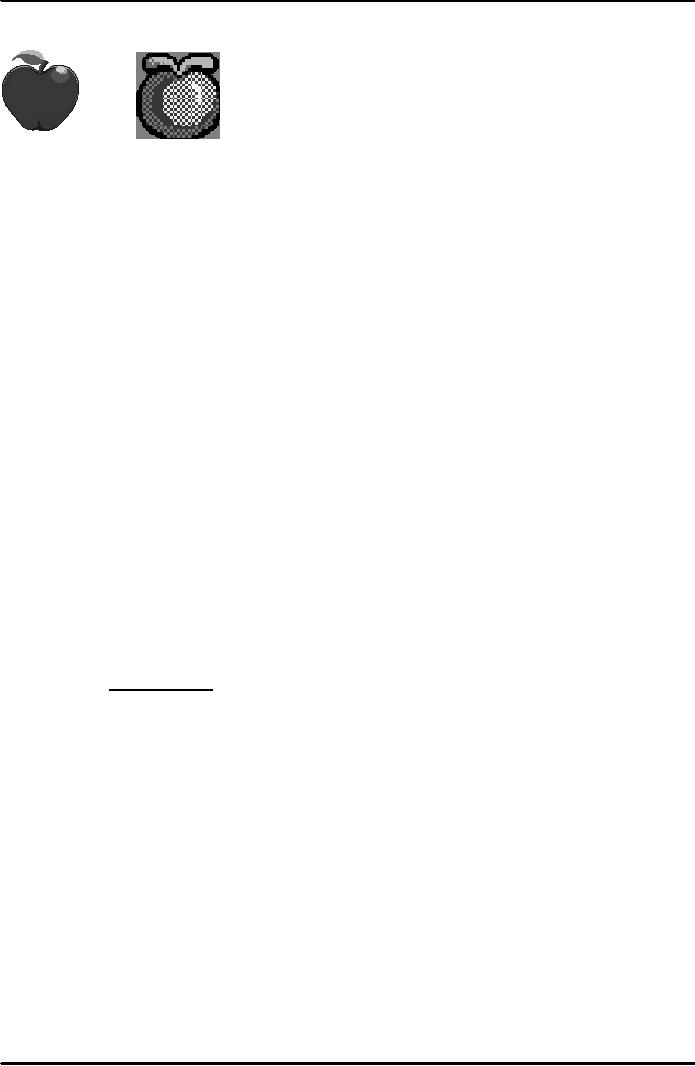 |
THE DATA OF MACROECONOMICS:Rules for computing GDP |
| << IMPORTANCE OF MACROECONOMICS:Interest rates and rental payments |
| THE DATA OF MACROECONOMICS (Continued…):Components of Expenditures >> |

Macroeconomics
ECO 403
VU
LESSON
04
THE DATA OF
MACROECONOMICS
THE
CIRCULAR FLOW
Income
(S)
Labor
Households
Firms
Goods
(bread)
Expenditure
($)
"Expenditure
= Income" Why?
In
every transaction,
the
buyer's expenditure becomes
the seller's income.
Thus,
the sum of all expenditure
equals
the
sum of all income
Rules
for computing GDP
1)
To compute the total value
of different goods and
services, the national
income
accounts
use market prices.
9

Macroeconomics
ECO 403
VU
Thus,
if
$0.50
$1.00
GDP
= [P (A) ×
Q
(A)] + [P (O) ×
Q
(O)]
=
($0.50 ×
4) +
($1.00 ×
3)
GDP
= $5.00
2)
Used goods are not
included
in the calculation of GDP.
3)
Treatment of inventories depends on if
the goods are stored or if
they spoil.
4)
Intermediate goods are not
counted in GDP only the
value of final goods.
Value
added of a firm
equals the value of the
firm's output less the
value of the
intermediate
goods
the firm purchases.
Example
·
A
farmer grows a bushel of
wheat and sells it to a
miller for $1.00
·
The
miller turns the wheat
into flour and sells it to a
baker for $3.00
·
The
baker uses the flour to
make a loaf of bread and
sells it to an engineer for
$6.00
·
The
engineer eats the
bread
·
Compute
value
added at each stage of
production
GDP
·
The
value of the final goods
already includes the value
of the intermediate goods,
so
including
intermediate goods in GDP
would be double-counting.
·
Thus,
Expenditure
= Income = Sum of value
added
5)
Some goods are not
sold in the marketplace and
therefore don't have market
prices. We
must
use their imputed value as
an estimate of their value.
For example, home ownership
and
government
services.
·
Apt
Rent will be included in
GDP.
Your
expenditure and landlord's
income
·
How
about people who own
houses?
They
pay themselves their
rent.
·
How
about services of police
officers, firefighters and
senators?
All
public goods and
services
·
These
are all included in
GDP.
10

Macroeconomics
ECO 403
VU
Nominal
vs Real GDP
·
The
value of final goods and
services measured at current
prices is called
nominal
GDP.
It
can change over time
either because there is a
change in the amount (real
value) of
·
goods
and services or a change in
the prices of those goods
and services.
Hence,
nominal GDP
·
Y=P×y
where
P
is
the price level &
y
is
real output
Real
GDP or,
·
y
= Y/P
is
the value of goods and
services measured using a
constant set of
prices?
This
distinction between real and
nominal can also be applied
to other monetary
·
values,
like wages. Nominal (or
money) wages can be denoted
by (W)
and
decomposed
into a real value (w) and a
price variable (P).
Hence,
W
=
nominal wage = P
x
w
w
=
real wage = W/P
This
conversion from nominal to
real units allows us to
eliminate the problems
created by
having
a measuring stick (dollar
value) that essentially
changes length over time, as
the price
level
changes.
Apple
& Orange Economy
Let's
see how real GDP is
computed in our apple and
orange economy.
For
example, if we wanted to compare
output in 2002 and output in
2003, we would obtain
base-year
prices, such as 2002
prices.
·
Real
GDP in 2002 would
be:
[2002
P (A) ×
2002 Q
(A)] + [2002 P(O) ×
2002
Q(O)]
Real
GDP in 2003 would
be:
·
[(2002
P (A) ×
2003 Q
(A)] + [(2002 P (O) ×
2003 Q
(O)]
Real
GDP in 2004 would
be:
·
[(2002
P (A) ×
2004 Q
(A)] + [(2002 P (O) ×
2004 Q
(O)]
11
Table of Contents:
- INTRODUCTION:COURSE DESCRIPTION, TEN PRINCIPLES OF ECONOMICS
- PRINCIPLE OF MACROECONOMICS:People Face Tradeoffs
- IMPORTANCE OF MACROECONOMICS:Interest rates and rental payments
- THE DATA OF MACROECONOMICS:Rules for computing GDP
- THE DATA OF MACROECONOMICS (Continued…):Components of Expenditures
- THE DATA OF MACROECONOMICS (Continued…):How to construct the CPI
- NATIONAL INCOME: WHERE IT COMES FROM AND WHERE IT GOES
- NATIONAL INCOME: WHERE IT COMES FROM AND WHERE IT GOES (Continued…)
- NATIONAL INCOME: WHERE IT COMES FROM AND WHERE IT GOES (Continued…)
- NATIONAL INCOME: WHERE IT COMES FROM AND WHERE IT GOES (Continued…)
- MONEY AND INFLATION:The Quantity Equation, Inflation and interest rates
- MONEY AND INFLATION (Continued…):Money demand and the nominal interest rate
- MONEY AND INFLATION (Continued…):Costs of expected inflation:
- MONEY AND INFLATION (Continued…):The Classical Dichotomy
- OPEN ECONOMY:Three experiments, The nominal exchange rate
- OPEN ECONOMY (Continued…):The Determinants of the Nominal Exchange Rate
- OPEN ECONOMY (Continued…):A first model of the natural rate
- ISSUES IN UNEMPLOYMENT:Public Policy and Job Search
- ECONOMIC GROWTH:THE SOLOW MODEL, Saving and investment
- ECONOMIC GROWTH (Continued…):The Steady State
- ECONOMIC GROWTH (Continued…):The Golden Rule Capital Stock
- ECONOMIC GROWTH (Continued…):The Golden Rule, Policies to promote growth
- ECONOMIC GROWTH (Continued…):Possible problems with industrial policy
- AGGREGATE DEMAND AND AGGREGATE SUPPLY:When prices are sticky
- AGGREGATE DEMAND AND AGGREGATE SUPPLY (Continued…):
- AGGREGATE DEMAND AND AGGREGATE SUPPLY (Continued…):
- AGGREGATE DEMAND AND AGGREGATE SUPPLY (Continued…)
- AGGREGATE DEMAND AND AGGREGATE SUPPLY (Continued…)
- AGGREGATE DEMAND AND AGGREGATE SUPPLY (Continued…)
- AGGREGATE DEMAND IN THE OPEN ECONOMY:Lessons about fiscal policy
- AGGREGATE DEMAND IN THE OPEN ECONOMY(Continued…):Fixed exchange rates
- AGGREGATE DEMAND IN THE OPEN ECONOMY (Continued…):Why income might not rise
- AGGREGATE SUPPLY:The sticky-price model
- AGGREGATE SUPPLY (Continued…):Deriving the Phillips Curve from SRAS
- GOVERNMENT DEBT:Permanent Debt, Floating Debt, Unfunded Debts
- GOVERNMENT DEBT (Continued…):Starting with too little capital,
- CONSUMPTION:Secular Stagnation and Simon Kuznets
- CONSUMPTION (Continued…):Consumer Preferences, Constraints on Borrowings
- CONSUMPTION (Continued…):The Life-cycle Consumption Function
- INVESTMENT:The Rental Price of Capital, The Cost of Capital
- INVESTMENT (Continued…):The Determinants of Investment
- INVESTMENT (Continued…):Financing Constraints, Residential Investment
- INVESTMENT (Continued…):Inventories and the Real Interest Rate
- MONEY:Money Supply, Fractional Reserve Banking,
- MONEY (Continued…):Three Instruments of Money Supply, Money Demand